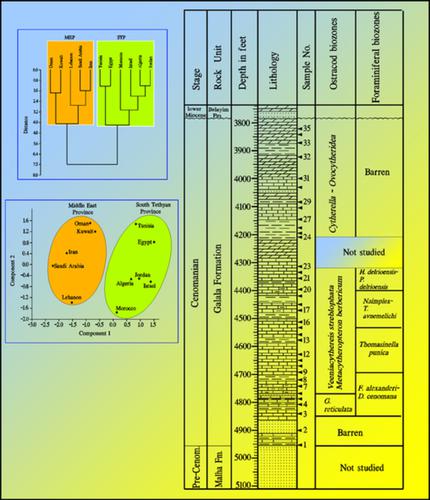当前位置:
X-MOL 学术
›
Geolog. J.
›
论文详情
Our official English website, www.x-mol.net, welcomes your
feedback! (Note: you will need to create a separate account there.)
Early–Middle Cenomanian foraminifera and ostracods from BB-80-1 well, Gulf of Suez, Egypt: Biostratigraphy, palaeoecology, and palaeobiogeographic significance
Geological Journal ( IF 1.4 ) Pub Date : 2021-03-30 , DOI: 10.1002/gj.4131 Abdalla Shahin 1 , Sherif M. El Baz 2
Geological Journal ( IF 1.4 ) Pub Date : 2021-03-30 , DOI: 10.1002/gj.4131 Abdalla Shahin 1 , Sherif M. El Baz 2
Affiliation

|
The present study concentrates on the foraminiferal and ostracod assemblages recorded from the subsurface Galala Formation in the northern part of the Gulf of Suez, Egypt. This investigation yielded 37 foraminiferal species (belonging to 26 genera, 10 superfamilies, and 14 families) and 25 ostracod species (belonging to 14 genera, 6 families, and 2 superfamilies). The foraminiferal assemblage is characterized by the dominance of typical Cenomanian agglutinated species with some planktonic species. The integration between benthic and planktonic foraminiferal species has led to the recognition of five proposed local biozones namely: Flabellammina alexanderi–Daxia cenomana Zone, Thomasinella fragmentaria Zone, Ismailia neumannae Zone, Nezzazata simplex–Trochospira avnemelichi Zone, and Hedbergella delrioensis–Praeglobotruncana delrioensis Zone. On the other hand, the stratigraphic distribution of the recorded ostracods resulted in the identification of four local biozones, involving Glenocythere reticulata Zone, Veeniacythereis streblolophata Zone, Spinoleberis yotvataensis Zone, and Cytherella–Ovocytheridea Zone. The recorded foraminifera are classified into five morphogroups and submorphogroups. Based on these morphogroups and other palaeoecological factors, five ecozones covering the Cenomanian are also distinguished. The palaeobiogeographical outline of the studied ostracod assemblages was carried out with the assistance of multivariate analyses (principal component analysis and Q-mode cluster analysis). The results point out that, there are two distinguished groups; one of them represents the South Tethyan Province (STP), including Morocco, Algeria, Tunisia, and Egypt. The second group represents the Middle East Province (MEP), including Oman, Lebanon, Saudi Arabia, Kuwait, and Iran. The strong affinity between the two provinces indicates a direct communication along the Southern Tethyan margin during the Cenomanian and enhanced marine faunal exchange.
中文翻译:

来自埃及苏伊士湾 BB-80-1 井的早-中 Cenomanian 有孔虫和介形虫:生物地层学、古生态学和古生物地理意义
目前的研究集中在埃及苏伊士湾北部的地下 Galala 组记录的有孔虫和介形虫组合。本次调查共发现有孔虫37种(隶属于26属、10属、14科)和介形虫25种(隶属于14属、6科、2属)。有孔虫组合的特点是典型的 Cenomanian 凝集物种和一些浮游物种占优势。底栖和浮游有孔虫物种之间的整合导致了五个拟议的当地生物区的认可,即:亚历山大藻-大夏 cenomana区、Thomasinella fragmentaria区、Ismailia neumannae区、Nezzazata simplex – Trochospira avnemelichi区和Hedbergella delrioensis – Praeglobotruncana delrioensis区。另一方面,记录的介形虫的地层分布导致识别出四个局部生物区,包括Glenocythere reticulata区、Veneacythereis streblolophata区、Spinoleberis yotvataensis区和Cytherella – Ovocytheridea区。记录的有孔虫分为五个形态群和亚形态群。基于这些形态群和其他古生态因素,还区分了覆盖森诺曼阶的五个生态区。在多变量分析(主成分分析和 Q 模式聚类分析)的帮助下,进行了所研究的介形虫组合的古生物地理轮廓。结果表明,有两个不同的群体;其中之一代表南特提斯省 (STP),包括摩洛哥、阿尔及利亚、突尼斯和埃及。第二组代表中东省(MEP),包括阿曼、黎巴嫩、沙特阿拉伯、科威特和伊朗。
更新日期:2021-03-30
中文翻译:

来自埃及苏伊士湾 BB-80-1 井的早-中 Cenomanian 有孔虫和介形虫:生物地层学、古生态学和古生物地理意义
目前的研究集中在埃及苏伊士湾北部的地下 Galala 组记录的有孔虫和介形虫组合。本次调查共发现有孔虫37种(隶属于26属、10属、14科)和介形虫25种(隶属于14属、6科、2属)。有孔虫组合的特点是典型的 Cenomanian 凝集物种和一些浮游物种占优势。底栖和浮游有孔虫物种之间的整合导致了五个拟议的当地生物区的认可,即:亚历山大藻-大夏 cenomana区、Thomasinella fragmentaria区、Ismailia neumannae区、Nezzazata simplex – Trochospira avnemelichi区和Hedbergella delrioensis – Praeglobotruncana delrioensis区。另一方面,记录的介形虫的地层分布导致识别出四个局部生物区,包括Glenocythere reticulata区、Veneacythereis streblolophata区、Spinoleberis yotvataensis区和Cytherella – Ovocytheridea区。记录的有孔虫分为五个形态群和亚形态群。基于这些形态群和其他古生态因素,还区分了覆盖森诺曼阶的五个生态区。在多变量分析(主成分分析和 Q 模式聚类分析)的帮助下,进行了所研究的介形虫组合的古生物地理轮廓。结果表明,有两个不同的群体;其中之一代表南特提斯省 (STP),包括摩洛哥、阿尔及利亚、突尼斯和埃及。第二组代表中东省(MEP),包括阿曼、黎巴嫩、沙特阿拉伯、科威特和伊朗。











































 京公网安备 11010802027423号
京公网安备 11010802027423号